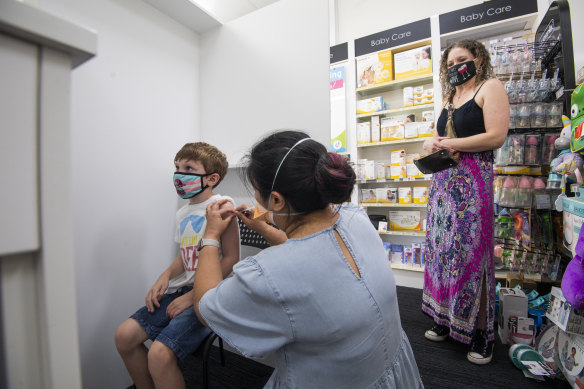- Analysis
- National
- Coronavirus pandemic
This was published 3 years ago
Why Australia lags behind the US on Omicron vaccines
By Liam Mannix
On Monday Australia’s drug regulator approved an updated COVID-19 vaccine designed to specifically target a variant that is no longer being detected in Australia.
The new bivalent vaccine was built to target the first version of Omicron we encountered, now known as BA.1. But BA.1 was dominant in Australia from January to March, before being replaced with BA2; BA5 has been dominant here since early July.

Christine Kelly administers a COVID vaccine to seven-year-old Cohen Doherty, while his mum, Leanne, watches.Credit: Louise Kennerley
The vaccine’s manufacturer, Moderna, points to data showing the vaccine works well against BA.5. But America has picked a different strategy, changing its approval process to allow it to quickly tick off an updated vaccine. On Wednesday America approved a BA.5 bivalent vaccine.
The contrasting strategies raise interesting questions about how regulators – who often set a plodding pace – will deal with a fast-moving virus that is constantly hunting ways around our defences.
“If we are delaying by four or five months the approval of a variant-based vaccine, there is a high probability that the variant will have been and gone,” says Professor Kim Mulholland, a leading global vaccine expert based at the Murdoch Children’s Research Institute.
“They should be getting into flu mode. You do a study on a not-very-large number of humans, and then based on your rapid results you activate the new update.”
In June America’s drug regulator told vaccine-makers they would not need to submit human clinical trial data for a BA.5 booster; animal data would be enough.
A spokesman for Australia’s Therapeutic Goods Administration said it was in talks with manufacturers about a vaccine for BA.5 but had not received any applications yet. The spokesman did not answer questions over whether the agency would consider using animal rather than human data.
Data published this week by researchers at the Kirby Institute suggest updated bivalent boosters do offer big improvements over the original vaccines, even if they are not up against the exact target variant.
Using data from laboratory studies, the team concluded that updated boosters increase antibody responses by, on average, 1.5 times as much as the original vaccine. Against the variant they directly target, that rises to 1.75
The improvement from a bivalent vaccine is not nearly as significant as getting a booster at all,” says study co-author Dr Deborah Cromer.
Approving an updated vaccine using animal data may raise eyebrows - particularly given concerns raised by some groups about the speed of original vaccine approvals. But it has precedent. Australian regulators approve one version of the updated influenza vaccine every year using animal data.
“The regulatory agencies have essentially said because the process stays the same they do not require human data,” says Professor Kanta Subbarao, director of the WHO Collaborating Centre for Reference and Research on Influenza at the Doherty Institute.
That strategy allows vaccine-makers to follow quickly changing influenza strains. COVID-19 poses similar challenges.
“The advantage is clearly that it potentially allows regulators to provide much more rapid access for recent strain-optimised versions of existing vaccines,” says Jim Buttery, head of epidemiology and signal detection at Victoria’s vaccine safety service.

A doctor gives a dose of the Moderna vaccine to a motorist in a drive-in vaccination station in an IKEA car park in Berlin, GermanyCredit: Carsten Koall/Getty Images
“The risks are clearly if there is an unanticipated change in the way the vaccine behaves in humans – safety, immunogenic, efficacy – it could undermine confidence.”
Indeed, scientists always caution animal studies are no substitute for human data. Influenza vaccines that work well in animals sometimes struggle to be effective in humans.
“It’s very difficult to extrapolate from humans to animals with influenza, because humans have had a lifetime of exposure [to the virus], says Subbarao. “Animals are usually immunologically naive.”
But given the speed the virus is changing at, the Kirby’s Cromer is sceptical our vaccines could ever truly catch up to it.
“The idea that we are specifically going to be able to match the circulating strain with a vaccine seems highly unlikely to me anyway. And our work suggests that boosting with any variant booster is still effective,” she says.
Liam Mannix’s Examine newsletter explains and analyses science with a rigorous focus on the evidence. Sign up to get it each week.